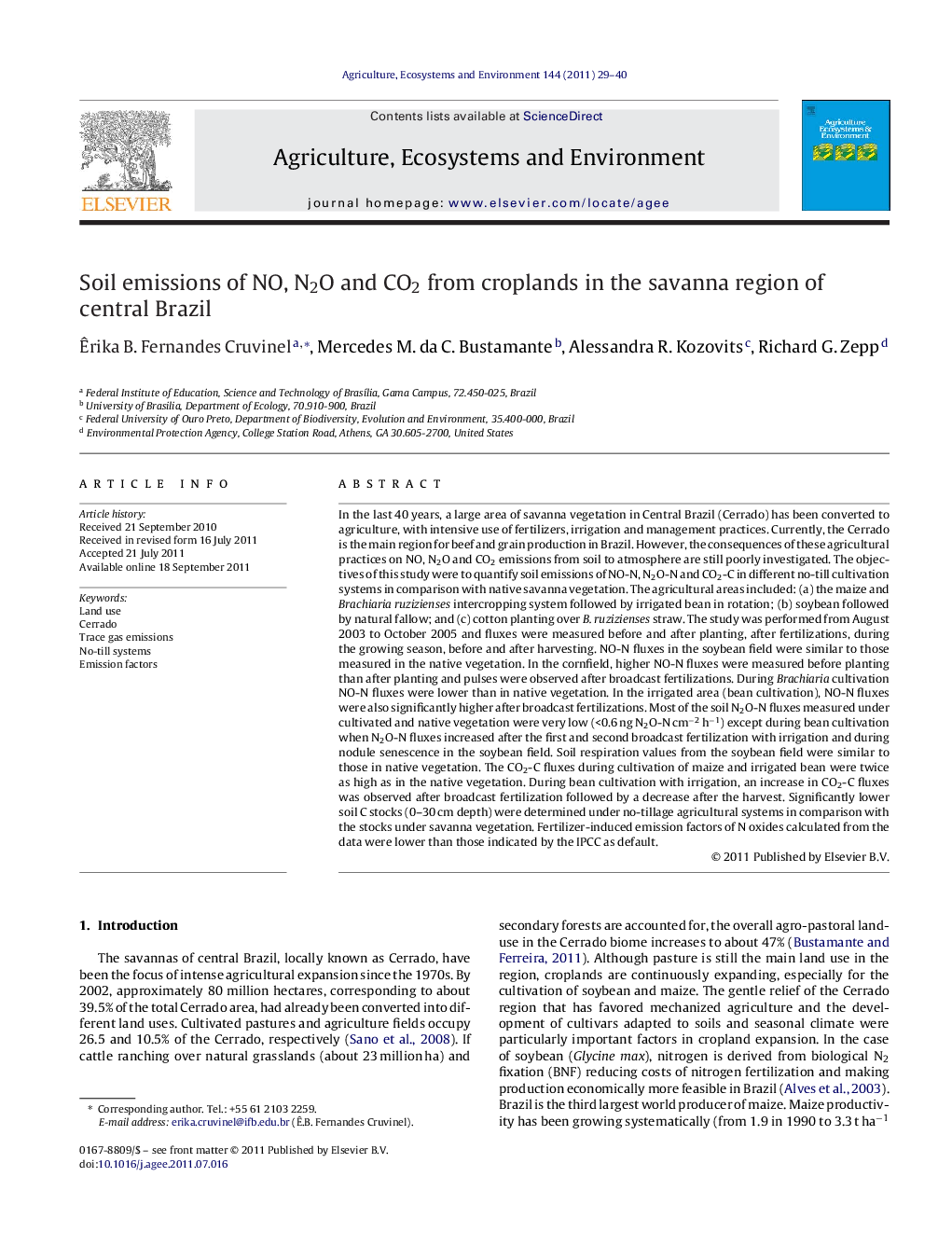| کد مقاله | کد نشریه | سال انتشار | مقاله انگلیسی | نسخه تمام متن |
|---|---|---|---|---|
| 2414751 | 1103929 | 2011 | 12 صفحه PDF | دانلود رایگان |

In the last 40 years, a large area of savanna vegetation in Central Brazil (Cerrado) has been converted to agriculture, with intensive use of fertilizers, irrigation and management practices. Currently, the Cerrado is the main region for beef and grain production in Brazil. However, the consequences of these agricultural practices on NO, N2O and CO2 emissions from soil to atmosphere are still poorly investigated. The objectives of this study were to quantify soil emissions of NO-N, N2O-N and CO2-C in different no-till cultivation systems in comparison with native savanna vegetation. The agricultural areas included: (a) the maize and Brachiaria ruzizienses intercropping system followed by irrigated bean in rotation; (b) soybean followed by natural fallow; and (c) cotton planting over B. ruzizienses straw. The study was performed from August 2003 to October 2005 and fluxes were measured before and after planting, after fertilizations, during the growing season, before and after harvesting. NO-N fluxes in the soybean field were similar to those measured in the native vegetation. In the cornfield, higher NO-N fluxes were measured before planting than after planting and pulses were observed after broadcast fertilizations. During Brachiaria cultivation NO-N fluxes were lower than in native vegetation. In the irrigated area (bean cultivation), NO-N fluxes were also significantly higher after broadcast fertilizations. Most of the soil N2O-N fluxes measured under cultivated and native vegetation were very low (<0.6 ng N2O-N cm−2 h−1) except during bean cultivation when N2O-N fluxes increased after the first and second broadcast fertilization with irrigation and during nodule senescence in the soybean field. Soil respiration values from the soybean field were similar to those in native vegetation. The CO2-C fluxes during cultivation of maize and irrigated bean were twice as high as in the native vegetation. During bean cultivation with irrigation, an increase in CO2-C fluxes was observed after broadcast fertilization followed by a decrease after the harvest. Significantly lower soil C stocks (0–30 cm depth) were determined under no-tillage agricultural systems in comparison with the stocks under savanna vegetation. Fertilizer-induced emission factors of N oxides calculated from the data were lower than those indicated by the IPCC as default.
Soil emissions of NO-N and N2O-N in agricultural ecosystems in the central Brazil were higher after broadcasting N-fertilization and irrigation. The NO-N and N2O-N emissions were also higher than native cerrado. Soil N2O-N (ng N2O-N cm−2 h−1) and NO-N (ng NO-N cm−2 h−1) fluxes in croplands and in native cerrado in the same period. (A) Dom Bosco Farm (from August 2003 to October 2004), (B) Pamplona Farm (from November 2004 to August 2005). Data points in Pamplona Farm represents N-NO log-scale.Figure optionsDownload as PowerPoint slideHighlights
► Losses of N in the form of NOx are higher than in the form of N2O-N.
► Agricultural practices induced higher NO-N and N2O-N emissions.
► Soil C stocks are lower under no-till soybean-natural fallow than native vegetation.
Journal: Agriculture, Ecosystems & Environment - Volume 144, Issue 1, November 2011, Pages 29–40